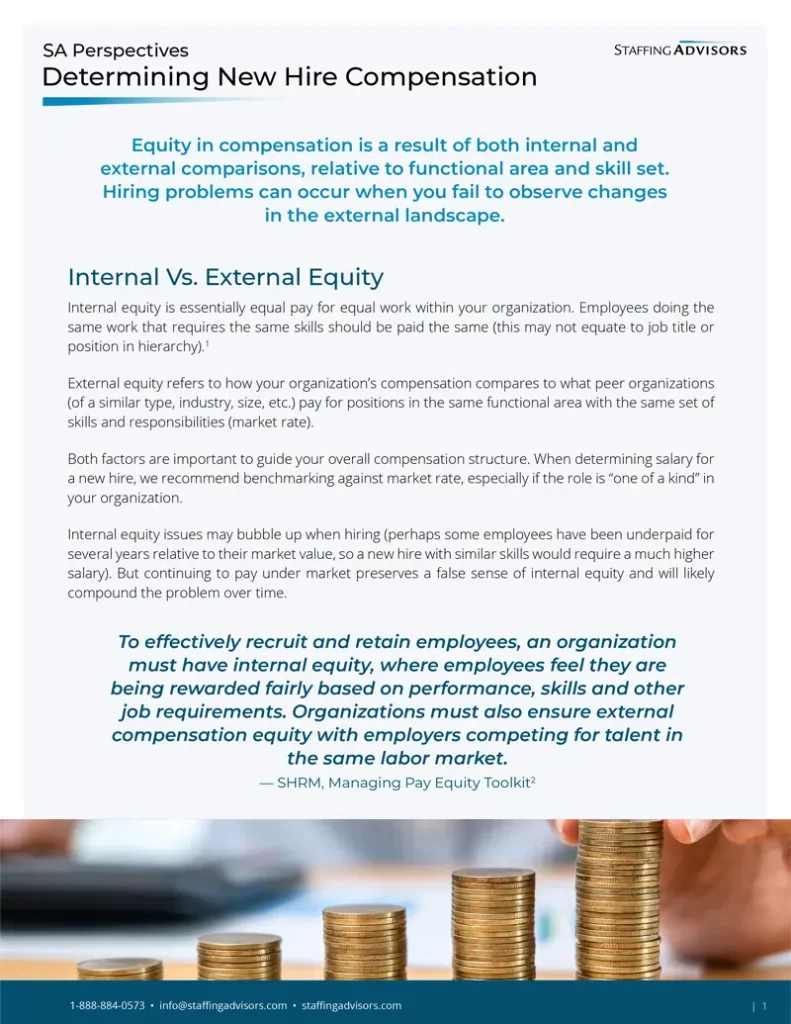Determining compensation requires making two kinds of comparisons: internal and external. And both are important to guide your overall pay structure. But hiring problems often stem from failing to observe changes in the external landscape—what peer organizations are paying for similar work in the current market. Here is the framework we suggest to help our clients determine a salary that attracts top candidates, supports a fair and inclusive hiring model, and ultimately leads to greater work satisfaction and retention.
Internal Pay Equity vs. External Pay Equity
Internal equity is essentially equal pay for equal work within your organization. Employees doing the same work that requires the same skills should be paid the same (this may not equate to job title or position in hierarchy).
External equity refers to how your organization’s compensation compares to what peer organizations (of a similar type, industry, size, etc.) pay for positions in the same functional area with the same set of skills and responsibilities (market rate).
When determining salary for a new hire, we recommend benchmarking against market rate, especially if the role is “one of a kind” in your organization.
Internal equity issues may bubble up when hiring (perhaps some employees have been underpaid for several years relative to their market value, so a new hire with similar skills would require a much higher salary). But continuing to pay under market preserves a false sense of internal equity and will likely compound the problem over time.
Market Value Compensation Framework
If you are looking externally for a new hire and want to recruit a top performer (a candidate who is demonstrably better than their peers at achieving the business results you require) we recommend benchmarking salary at the 50th percentile (median) of market rate relative to jobs that require the same competencies in the same functional area at peer organizations.
For example, an IT director has an entirely different set of skills than a communications director. Each should be paid market value relative to their specific set of skills—it is unlikely to be consistent across functional areas within your organization.
Paying your IT director the same salary as your communications director is not necessarily equitable because the external market rate for their skills might be very different. You could end up overpaying for one role while creating a future challenge in recruiting for the other.
Using Multiple Data Points
When determining the 50th percentile, using multiple data points will provide a more accurate representation of the current market. This reduces the risk of relying on skewed or potentially unreliable information from a single source.
We recommend using a compensation consultant who draws from multiple compensation surveys, which may include PRM, NCA, ASAE, ERI, and more. Using only one survey can be misleading.
Beyond the information found in surveys, we also recommend gathering salary expectations from promising candidates and using the midpoint of their expectations to inform your judgment.
Why We Recommend This Approach
True pay equity comes from paying all employees fairly, relative to what other employers offer for that particular skill set (for example, always paying 50th percentile of the market for every functional area). Your total reward strategy may emphasize other factors like contributions to retirement, healthcare, etc., but this is the baseline approach we recommend for salary. Here’s why.
Market Value Pay Attracts Top Performers
In any market, there is competition for highly qualified candidates—they likely have several good options to choose from. And with the rise in pay transparency, candidates increasingly know their worth and can compare salary ranges of similar roles at a glance. Paying market value increases your appeal to candidates who are in high demand and are comparing your job to others.
Market Value Pay Supports Inclusive Hiring
Fair market compensation is a building block of equity in hiring. While we understand budget constraints, offering below-market salary while expecting to attract candidates from diverse backgrounds can unintentionally perpetuate cycles of lower pay. This applies to racial and ethnic groups that have been historically underrepresented and underpaid in various professions. It also extends to any minority group within a specific industry or functional area, such as women in STEM.
Market Value Pay Leads to Greater Retention and Work Satisfaction
Employees who think they are paid under market are 50% more likely to look for a new job. Those who are hired at and continue to be paid fair market value throughout their tenure are more likely to stay with an organization, given that other work satisfaction factors remain constant. And workers tend to be more productive and engaged when they think they are paid fairly.
Take It With You
Download a pdf of this article to share with your team (no email or signup required).

Related Resources
- For a more detailed framework to determine salary based on factors like performance expectations, turnover, supply of talent, industry stability, and more, read our (updated) 2013 post Determining Salary for a New Hire? Think Like a Compensation Pro.
- Defining a new job can be a daunting task but it is well worth the time and effort. For step-by-step guidance, read How To Define a New Role in Your Association or Nonprofit.
